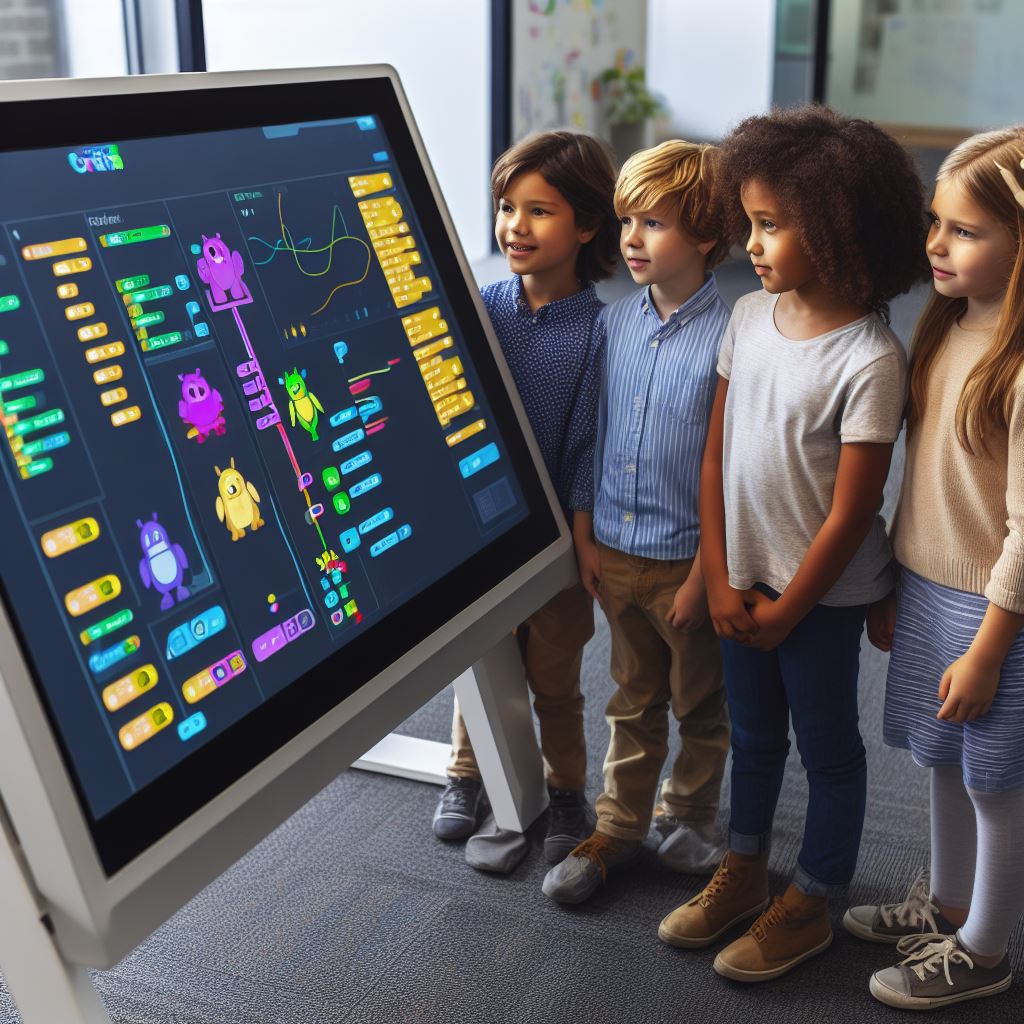Introduction
Scratch, a coding platform developed by the MIT Media Lab, has revolutionized the way young people learn and engage with coding.
With its user-friendly interface and drag-and-drop programming blocks, Scratch provides an accessible entry point for beginners to express their creativity through coding.
Its vast online community and gallery of shared projects further inspire and motivate future coders to explore the endless possibilities of programming.
The importance of inspiring future coders cannot be overstated.
In today’s digital age, coding skills are becoming increasingly essential for success in various fields, including computer science, engineering, and even art and design.
By introducing young minds to coding through platforms like Scratch, we nurture their problem-solving abilities, critical thinking skills, and creativity, preparing them to thrive in an ever-evolving technological landscape.
Moreover, Scratch has produced numerous real-life success stories, where individuals who started their coding journeys on this platform have gone on to achieve remarkable feats.
One such example is the story of Jane, a young girl who discovered Scratch in her school’s computer lab. Inspired by the possibilities it offered, she immersed herself in projects, gradually building her coding skills.
Over time, her passion for coding grew, and she began to explore advanced languages and frameworks.
Jane’s journey with Scratch not only developed her technical abilities but also fostered her self-confidence and resilience.
She realized that coding was not limited to a gender or age group and that anyone could learn and excel at it.
Through her dedication and determination, Jane secured internships at prestigious tech companies, participated in hackathons, and ultimately landed a job as a software engineer at a renowned technology company.
Jane’s success story is just one of many that highlight how Scratch shapes future coders.
Its intuitive interface, creative environment, and supportive community have transformed countless young learners into confident problem solvers and innovative thinkers.
By inspiring and empowering future coders, Scratch is paving the way for a generation that will use their coding skills to tackle real-world challenges and shape the future of technology.
Tech Consulting Tailored to Your Coding Journey
Get expert guidance in coding with a personalized consultation. Receive unique, actionable insights delivered in 1-3 business days.
Get StartedRead: Mastering Scratch Scripting: Advanced Concepts Explained
Overview of Scratch’s impact on future coders
Accessibility and user-friendly nature of Scratch
One of the most remarkable aspects of Scratch is its accessibility and user-friendly nature.
As a visual programming language, Scratch allows individuals, especially young learners, to easily understand and engage with coding concepts.
Unlike traditional coding languages, Scratch uses colorful blocks that snap together, eliminating the need to type out complex lines of code.
By removing the intimidating barriers of syntax and typing, Scratch opens up the world of coding to a wider audience.
Young learners, who may have no prior experience or knowledge of coding, can effortlessly grasp fundamental programming concepts.
Scratch’s simple and intuitive interface empowers them to experiment, explore, and express their creativity through coding.
Scratch’s ability to cultivate creativity and problem-solving skills
One of the key benefits of Scratch is its ability to cultivate creativity and problem-solving skills in future coders.
Scratch not only focuses on teaching programming concepts but also encourages students to think critically and come up with innovative solutions.
With Scratch, users can create interactive stories, animations, games, and more. This freedom to design and develop their projects unleashes their creativity and imagination.
Through experimentation and iteration, young coders learn how to solve problems, overcome challenges, and think logically.
By designing projects from scratch, students learn to break down complex problems into smaller, more manageable tasks.
They acquire essential skills like algorithmic thinking and logical reasoning, which are crucial in the world of coding.
The community aspect and sharing of projects
A vital component of Scratch’s impact on future coders is its strong community aspect and the ability to share projects.
Build Your Vision, Perfectly Tailored
Get a custom-built website or application that matches your vision and needs. Stand out from the crowd with a solution designed just for you—professional, scalable, and seamless.
Get StartedOn the Scratch platform, users can showcase their creations, collaborate with others, and gain inspiration from a vast array of projects shared by fellow coders.
This interactive and collaborative environment fosters a sense of belonging and encourages learners to support one another.
Students can explore other projects, learn from different coding approaches, and even remix existing projects to create something new.
This sharing culture not only enhances technical skills but also instills important values such as collaboration, communication, and empathy.
Through feedback and constructive criticism, learners can improve their coding abilities and develop a deeper understanding of programming concepts.
Moreover, the Scratch community spans globally, connecting young coders from diverse backgrounds.
This exposure to different perspectives and cultures broadens their horizons and prepares them to thrive in a globally interconnected world.
In essence, Scratch has a transformative impact on future coders by making coding accessible and user-friendly, cultivating creativity and problem-solving skills, and fostering a strong community of young coders.
By leveraging Scratch’s power, we can empower the next generation of coders to shape the digital landscape with their innovative ideas and creations.
Read: Staying Updated: The Best Coding Blogs and Resources
Real-life success stories of coders influenced by Scratch
Samaira Mehta
Samaira Mehta started coding with Scratch at the age of 7. Her early exposure to programming led her to create “CoderBunnyz,” a board game that teaches kids how to code.
She’s since been recognized for her entrepreneurial spirit and coding advocacy.
Samaira Mehta discovered Scratch at a young age and immediately became captivated by its possibilities.
From Scratch, she progressed into learning more advanced coding languages and techniques.
Optimize Your Profile, Get Noticed
Make your resume and LinkedIn stand out to employers with a profile that highlights your technical skills and project experience. Elevate your career with a polished and professional presence.
Get NoticedSamaira’s accomplishments include creating “CoderBunnyz” and advocating for coding education, all thanks to Scratch.
Shemar Coombs
Shemar Coombs, a teenager from Jamaica, began coding with Scratch and later learned Python.
He developed a web app called “GradeMate” to help students calculate their grades. His story has inspired other young coders in his community.
Shemar Coombs got introduced to Scratch and started working on small projects to understand its concepts.
With time, he transitioned into more complex coding tasks using Python, expanding his skill set.
Shemar’s notable achievement is the development of “GradeMate” and his role in inspiring young coders in his community.
Gitanjali Rao
Gitanjali Rao, Time magazine’s 2020 Kid of the Year, used Scratch to create her first app when she was just 11 years old.
Her app, “Kindly,” helps combat cyberbullying by providing a safe space for students to report incidents.
Gitanjali Rao’s journey with Scratch differed from the previous stories, as she used it to develop an app.
Despite facing challenges along the way, Gitanjali overcame them with perseverance and determination.
Her significant achievements include creating the app “Kindly” and making a positive impact in combating cyberbullying.
These real-life success stories demonstrate the influence of Scratch on young coders’ lives.
Scratch serves as a stepping stone for these individuals, opening doors to advanced coding languages and allowing them to achieve remarkable accomplishments.
These stories highlight the transformative power of Scratch in fostering creativity, problem-solving skills, and entrepreneurial thinking in young minds.
Through Scratch, children are empowered to turn their ideas into tangible projects, and their success stories inspire others to embark on their coding journeys.
As we continue to witness more success stories influenced by Scratch, it becomes evident that this beginner-friendly programming language plays a crucial role in shaping future coders.
With its accessibility and engaging nature, Scratch continues to empower young individuals, equipping them with the skills they need to thrive in the digital world.
Read: Top Cities in the U.S. for Coding Job Opportunities

The broader impact of Scratch on the coding landscape
Coding education in schools and beyond
Scratch has had a significant influence on coding education in schools and beyond. It has revolutionized the way programming is taught, making it accessible to students of all ages and backgrounds.
By using a visual programming language, Scratch has made coding more interactive and engaging, giving students the opportunity to develop their problem-solving and computational thinking skills in a fun and creative way.
Many schools have incorporated Scratch into their curriculum, creating dedicated coding classes or integrating it into other subjects such as math or science.
This has allowed students to apply their coding skills in real-life scenarios, enhancing their understanding and motivation to learn.
Beyond formal education settings, Scratch has also influenced coding education in informal environments, such as coding clubs or after-school programs.
Its intuitive interface and community-driven support have made it a popular choice for educators and learners outside of traditional classrooms.
Reducing the gender gap in coding
Scratch has played a crucial role in reducing the gender gap in coding.
Traditionally, coding has been dominated by males, but Scratch has helped to bridge this gap by providing a welcoming and inclusive environment for everyone.
The design and features of Scratch appeal to a diverse audience, including girls who may have been discouraged from pursuing coding due to societal stereotypes or lack of representation in the field.
Scratch’s emphasis on creativity and storytelling has made coding more relatable and appealing to girls and other underrepresented groups.
Furthermore, the Scratch community actively encourages diversity and inclusivity.
Scratch has enabled girls and other marginalized groups to showcase their coding skills actively.
It has done this through coding competitions, workshops, and mentorship programs, providing recognition in the coding community.
Scratch’s impact extends beyond personal success. It shifted perceptions, encouraging girls to pursue STEM, empowering future coders.
Collaborations and partnerships for advancing coding skills
Scratch has formed numerous collaborations and partnerships with other organizations to advance coding skills and promote digital literacy.
One notable partnership is with the MIT Media Lab, where Scratch was developed.
MIT’s involvement has provided a solid foundation for comprehensive research and ongoing development of Scratch and its educational resources.
Scratch has also partnered with organizations like Code.org, a nonprofit dedicated to expanding access to computer science education.
Together, they have developed curricula and resources to introduce coding to millions of students around the world.
In addition, Scratch has collaborated with museums, libraries, and other educational institutions to host coding workshops and events.
These partnerships have not only increased awareness and usage of Scratch but also facilitated the sharing of best practices and innovative teaching methods.
Furthermore, Scratch has fostered collaborations between educators and learners through its online community.
This platform allows users to share projects, provide feedback, and collaborate on coding challenges, creating a vibrant and supportive network of coding enthusiasts.
In fact, Scratch has made a profound impact on the coding landscape by influencing coding education, reducing the gender gap, and forming collaborations to advance coding skills.
Its user-friendly interface, emphasis on creativity, and inclusive community have transformed the way coding is taught and experienced, paving the way for future generations of skilled coders.
Read: Entry-Level Coding Jobs: What to Expect and Prepare
Conclusion
In this guide, we discussed the success stories of future coders who started with Scratch. Scratch has played a significant role in shaping these coders and their achievements.
It is evident that Scratch provides a solid foundation and fosters creativity and problem-solving skills. By using Scratch, coders have been able to create innovative projects and gain real-world experience.
The success stories shared here should inspire aspiring coders to consider using Scratch. Scratch not only teaches coding concepts but also encourages collaboration and critical thinking.
It is an accessible platform that empowers individuals to express their ideas through coding. As technology becomes increasingly important, learning Scratch can open new doors for future coders.
We encourage readers to explore Scratch and discover the limitless possibilities it offers. Whether it’s creating games, animations, or interactive artwork, Scratch provides the tools to turn ideas into reality.
By engaging with Scratch, readers can embark on their coding journey and shape their own future success.
It is with enthusiasm that we invite you to dive into Scratch and unlock your creative potential as a future coder.




